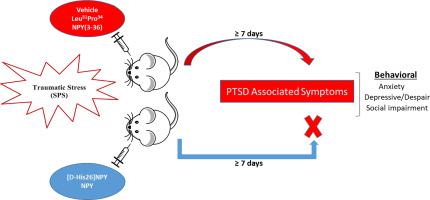当前位置:
X-MOL 学术
›
Neuropeptides
›
论文详情
Our official English website, www.x-mol.net, welcomes your
feedback! (Note: you will need to create a separate account there.)
Activation of NPY receptor subtype 1 by [D-His26]NPY is sufficient to prevent development of anxiety and depressive like effects in the single prolonged stress rodent model of PTSD
Neuropeptides ( IF 2.5 ) Pub Date : 2020-04-01 , DOI: 10.1016/j.npep.2019.102001 Chiso Nwokafor 1 , Lidia I Serova 1 , Roxanna J Nahvi 1 , Jaclyn McCloskey 1 , Esther L Sabban 1
Neuropeptides ( IF 2.5 ) Pub Date : 2020-04-01 , DOI: 10.1016/j.npep.2019.102001 Chiso Nwokafor 1 , Lidia I Serova 1 , Roxanna J Nahvi 1 , Jaclyn McCloskey 1 , Esther L Sabban 1
Affiliation

|
The neuropeptide Y (NPY) system plays an important role in mediating resilience to the harmful effect of stress in post-traumatic stress disorder (PTSD). It can mediate its effects via several G-protein coupled receptors: Y1R, Y2R, Y4R and Y5R. To investigate the role of individual NPY receptors in the resilience effects of NPY to traumatic stress, intranasal infusion of either Y1R agonists [D-His26]NPY, [Leu31Pro34]NPY, Y2R agonist NPY (3-36) or NPY were administered to male Sprague-Dawley rats immediately following the last stressor of the single prolonged stress (SPS) protocol, a widely used PTSD animal model. After 7 or 14 days, effects of the treatments were measured on the elevated plus maze (EPM) for anxiety, in forced swim test (FST) for development of depressive-like or re-experiencing behavior, in social interaction (SI) test for impaired social behavior, and acoustic startle response (ASR) for hyperarousal. [D-His26]NPY, but not [Leu31Pro34]NPY nor NPY (3-36) Y2R, was effective in preventing the SPS-elicited development of anxiety. Y1R, but not Y2R agonists prevented development of depressive- feature on FST, with [D-His26]NPY superior to NPY. The results demonstrate that [D-His26]NPY was sufficient to prevent development of anxiety, social impairment and depressive symptoms, and has promise as an early intervention therapy following traumatic stress.
中文翻译:

[D-His26]NPY 激活 NPY 受体亚型 1 足以防止在 PTSD 的单一长期应激啮齿动物模型中出现焦虑和抑郁样效应
神经肽 Y (NPY) 系统在介导对创伤后应激障碍 (PTSD) 中压力有害影响的恢复力方面发挥重要作用。它可以通过几种 G 蛋白偶联受体介导其作用:Y1R、Y2R、Y4R 和 Y5R。为了研究单个 NPY 受体在 NPY 对创伤性压力的弹性影响中的作用,将 Y1R 激动剂 [D-His26]NPY、[Leu31Pro34]NPY、Y2R 激动剂 NPY (3-36) 或 NPY 鼻内输注给男性Sprague-Dawley 大鼠紧随单一长期压力 (SPS) 协议(一种广泛使用的 PTSD 动物模型)的最后一个压力源。7 或 14 天后,在高架十字迷宫 (EPM) 上测量治疗效果,用于焦虑,在强迫游泳测试 (FST) 中测量抑郁样或重新体验行为的发展,在社交行为受损的社交互动 (SI) 测试和过度觉醒的声学惊吓反应 (ASR) 测试中。[D-His26]NPY,但不是 [Leu31Pro34]NPY 或 NPY (3-36) Y2R,可有效防止 SPS 诱发的焦虑发展。Y1R,而不是 Y2R 激动剂阻止了 FST 抑郁特征的发展,[D-His26]NPY 优于 NPY。结果表明,[D-His26]NPY 足以预防焦虑、社交障碍和抑郁症状的发展,并有望作为创伤性压力后的早期干预疗法。[D-His26]NPY 优于 NPY。结果表明,[D-His26]NPY 足以预防焦虑、社交障碍和抑郁症状的发展,并有望作为创伤性压力后的早期干预疗法。[D-His26]NPY 优于 NPY。结果表明,[D-His26]NPY 足以预防焦虑、社交障碍和抑郁症状的发展,并有望作为创伤性压力后的早期干预疗法。
更新日期:2020-04-01
中文翻译:

[D-His26]NPY 激活 NPY 受体亚型 1 足以防止在 PTSD 的单一长期应激啮齿动物模型中出现焦虑和抑郁样效应
神经肽 Y (NPY) 系统在介导对创伤后应激障碍 (PTSD) 中压力有害影响的恢复力方面发挥重要作用。它可以通过几种 G 蛋白偶联受体介导其作用:Y1R、Y2R、Y4R 和 Y5R。为了研究单个 NPY 受体在 NPY 对创伤性压力的弹性影响中的作用,将 Y1R 激动剂 [D-His26]NPY、[Leu31Pro34]NPY、Y2R 激动剂 NPY (3-36) 或 NPY 鼻内输注给男性Sprague-Dawley 大鼠紧随单一长期压力 (SPS) 协议(一种广泛使用的 PTSD 动物模型)的最后一个压力源。7 或 14 天后,在高架十字迷宫 (EPM) 上测量治疗效果,用于焦虑,在强迫游泳测试 (FST) 中测量抑郁样或重新体验行为的发展,在社交行为受损的社交互动 (SI) 测试和过度觉醒的声学惊吓反应 (ASR) 测试中。[D-His26]NPY,但不是 [Leu31Pro34]NPY 或 NPY (3-36) Y2R,可有效防止 SPS 诱发的焦虑发展。Y1R,而不是 Y2R 激动剂阻止了 FST 抑郁特征的发展,[D-His26]NPY 优于 NPY。结果表明,[D-His26]NPY 足以预防焦虑、社交障碍和抑郁症状的发展,并有望作为创伤性压力后的早期干预疗法。[D-His26]NPY 优于 NPY。结果表明,[D-His26]NPY 足以预防焦虑、社交障碍和抑郁症状的发展,并有望作为创伤性压力后的早期干预疗法。[D-His26]NPY 优于 NPY。结果表明,[D-His26]NPY 足以预防焦虑、社交障碍和抑郁症状的发展,并有望作为创伤性压力后的早期干预疗法。









































 京公网安备 11010802027423号
京公网安备 11010802027423号